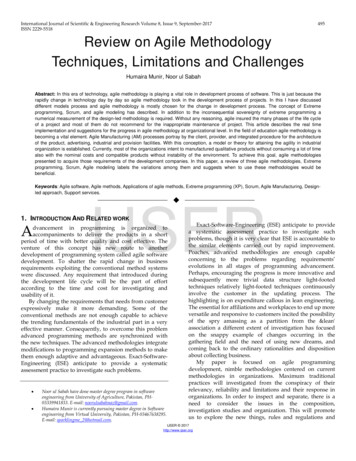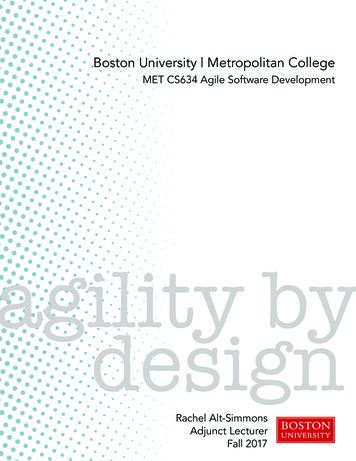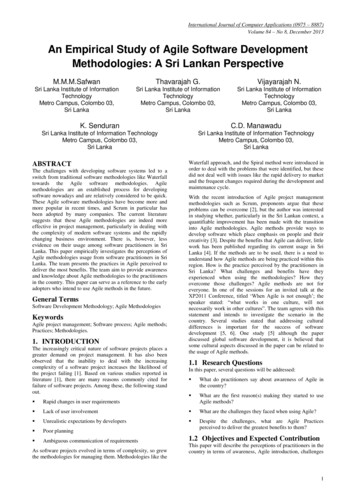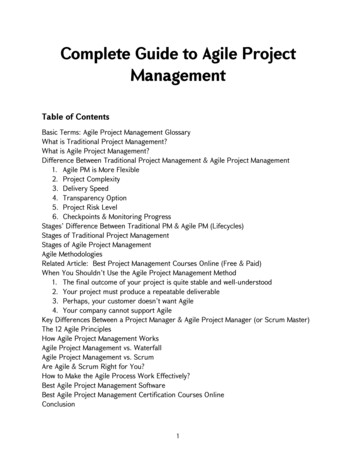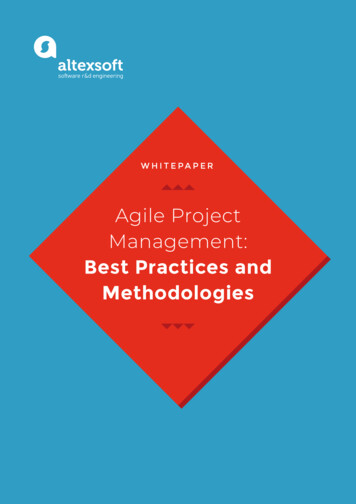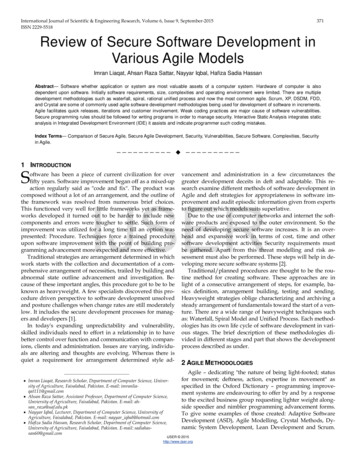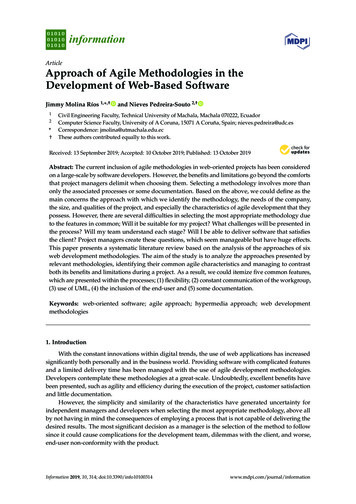
Transcription
informationArticleApproach of Agile Methodologies in theDevelopment of Web-Based SoftwareJimmy Molina Ríos 1, *,†12*†and Nieves Pedreira-Souto 2,†Civil Engineering Faculty, Technical University of Machala, Machala 070222, EcuadorComputer Science Faculty, University of A Coruna, 15071 A Coruña, Spain; nieves.pedreira@udc.esCorrespondence: jmolina@utmachala.edu.ecThese authors contributed equally to this work.Received: 13 September 2019; Accepted: 10 October 2019; Published: 13 October 2019 Abstract: The current inclusion of agile methodologies in web-oriented projects has been consideredon a large-scale by software developers. However, the benefits and limitations go beyond the comfortsthat project managers delimit when choosing them. Selecting a methodology involves more thanonly the associated processes or some documentation. Based on the above, we could define as themain concerns the approach with which we identify the methodology, the needs of the company,the size, and qualities of the project, and especially the characteristics of agile development that theypossess. However, there are several difficulties in selecting the most appropriate methodology dueto the features in common; Will it be suitable for my project? What challenges will be presented inthe process? Will my team understand each stage? Will I be able to deliver software that satisfiesthe client? Project managers create these questions, which seem manageable but have huge effects.This paper presents a systematic literature review based on the analysis of the approaches of sixweb development methodologies. The aim of the study is to analyze the approaches presented byrelevant methodologies, identifying their common agile characteristics and managing to contrastboth its benefits and limitations during a project. As a result, we could itemize five common features,which are presented within the processes; (1) flexibility, (2) constant communication of the workgroup,(3) use of UML, (4) the inclusion of the end-user and (5) some documentation.Keywords: web-oriented software; agile approach; hypermedia approach; web developmentmethodologies1. IntroductionWith the constant innovations within digital trends, the use of web applications has increasedsignificantly both personally and in the business world. Providing software with complicated featuresand a limited delivery time has been managed with the use of agile development methodologies.Developers contemplate these methodologies at a great-scale. Undoubtedly, excellent benefits havebeen presented, such as agility and efficiency during the execution of the project, customer satisfactionand little documentation.However, the simplicity and similarity of the characteristics have generated uncertainty forindependent managers and developers when selecting the most appropriate methodology, above allby not having in mind the consequences of employing a process that is not capable of delivering thedesired results. The most significant decision as a manager is the selection of the method to followsince it could cause complications for the development team, dilemmas with the client, and worse,end-user non-conformity with the product.Information 2019, 10, 314; mation
Information 2019, 10, 3142 of 21Although there are studies that identify the problems encountered during web projects, researchthat proposes the most important characteristics of web development methodologies is meager andnot very detailed, with little consideration to the approaches that the methodologies must possess.It is indisputable that web development includes a great diversity of approaches that developersconsider when executing a web project. These approaches vary depending on the methodology tobe used; considered relevant are the hypermedia approach (content-based, and task-based), the agiledevelopment approach, and finally the end user-based approach.The proposed objective of this article is to identify the common agile characteristics of webdevelopment methodologies through the analysis of the approach of the six that have a more prominentimportance in the literature. Also, to present the approach that has greater transcendence during theprocesses of web development, offering its benefits and limitations during the project.The rest of this document is structured as follows—the framework used to understand the relatedwork and the methodological process to carry out the systematic review of the literature are presentedin Section 2, while Section 3 presents the results of the analysis and extraction of data executed throughthe SLR Procedure. Section 4 offers a discussion of the results, followed by conclusions and futurework in Section 5.2. Materials and MethodsTraditional development processes are very different to agile development processes.These include the stages for the life cycle of the product because they are not as flexible as theagile ones [1]. That is to say, in the stages of elicitation and analysis of requirements.Agile methodologies were created to improve the software development process and the problemsassociated with the use of traditional methodologies, which presents rigidity and an extensivedocumentation process [2], as well as arising from best practice ideas from the object-oriented community.2.1. Web-Oriented Software Development MethodologiesWeb-oriented software presents a certain degree of difficulty for its design and development,due to the characteristics that must cover the duration of the life cycle. One of the main complexities isthe accessibility of applications, which is due to the development of both the team and the system [3].According to Torrecilla, Sedeño, Escalona & Mejías, the different development methodologies inweb engineering “concentrate essentially on the development phases and do not cover other areas,such as project estimation; quality assurance or team management” [4]. Many web developmentmethodologies arise from the need to implement new features within life cycle processes so theyevolve and employ concepts from existing methodologies [5] that define three essential models thatare exhibited in Figure 1.Figure 1. Web design models.
Information 2019, 10, 3143 of 21Most web development methodologies embed these models in their design and creation stages. Domain Model: Also known as a conceptual model, it describes the content of the application tobe designed.Navigation Model: This model defines the navigation between the different pages that will makeup the system.Presentation model: It specifies the content of the presentation of the pages towards the users,focuses on the user interface to be presented.WebML: This methodology is used to develop web applications driven by processes andalso to implement the business model [6], in addition to being used for the specification ofcomplex requirements. Three levels are represented through unified modeling language—appearance,data transformation and content objects [1].This is not just a methodology, it is also considered a language for the modeling and designof web-oriented applications wherein four relevant models are defined—the structural model,the hypertext model, the presentation model and the personalize model [7].OOHDM: The life cycle used by the OOHDM (Object-Oriented Hypermedia Design Model)methodology, for the design and development of information systems, is established in three differentmodels—the conceptual model, the presentation model and the navigation model [8]. As it is amethodology oriented to hypermedia, it bases its concepts on the design and stages that it possesses.This uses Object-Oriented data modeling to create a conceptual model [9].W2000: The conceptual model used by the W2000 methodology is based on schemes, as wellas other models oriented to the development of web applications, among them—for the design ofexecution, diffusion design, design of direction or navigation and finally the design of information [10].The main focus of the methodology is in the requirements specification phase wherein it neatly makesuse of UML notation to model the functional and navigational requirements for hypermedia design.UWE: In the development of web applications, the UWE methodology stands out for thepractical documentation it uses from the creation phase, using the diagrams established by UMLnotation, clarifying the creation of objects or elements that intervene in each process of the webapplication [11]. UWE’s features allow the covering of the entire software life cycle of web applicationswhile maintaining a user focus and its structure is an iterative and incremental model, which facilitatesthe control of constant changes in phases during project execution.WSDM: It is considered a methodology due to its versatile characteristics in the developmentof applications in short periods. It is also an end-user based methodology considering the user asthe main pivot of the system. However, this methodology needs a complementary methodology thatcarries out the project management taking control over the software life cycle [12].NDT: According to Reference [13], NDT is a methodology that maintains a specific focus onrequirements engineering, taking the objectives as guidelines for carrying out the requirementscollection and validation processes. It then classifies them into information storage requirements,stakeholder requirements, functional, interaction and non-functional requirements.2.2. Approach to Development Methodologies2.2.1. Development Approach based on HypermediaCommonly, hypermedia applications are categorized into two approaches or architectures, the firstconcerning the content of the application, and the second focusing on the tasks or procedures theyperform. According to Suh & Lee [14], among the development methodologies with a focus on tasksare SOHDM, EORM, WHDM; while those based on content are RMM, OOHDM, VHDM.
Information 2019, 10, 314 4 of 21Content-driven ApproachThe content-based approach concentrates on structuring the hypermedia information neededto meet user needs. The project manager must establish the content employed in each node or page.In this way, it is possible to cover the objectives proposed in the planning of the project. Task-driven ApproachBetter interaction with the user is created by separating the concerns related to the projectaccording to the task. Also, this generates a better structure over the processes. The use of a task-basedapproach gives a prominent advantage during the gathering of system functional requirements.This taxonomy provides an overview of the tasks that users must perform to interact with webapplications hierarchically [15].2.2.2. Agile Approach to Development MethodologiesThe development of applications based on a framework of agile methodologies is implicitlysubject to the use of values, principles and agile practices, which positively favor the construction ofapplications by diminishing aspects such as effort and time. On the other hand, the agile approachgives the faculty to be flexible to the changes generated throughout the life cycle. According to Herreraand Valencia [16], the agile manifesto employs four values during software development: Individuals and interactions above processes and tools.Software running above documentation.Customer collaboration over contract negotiation.Responding to change over following a plan.Unlike traditional methodologies, agile ones focus on the users involved in the system andgive priority to the software functionality rather than the rigorous documentation proposed byothers. Additionally, it encourages the practice of support for change, leaving aside the inflexibility tomodifications that the application may undergo throughout the life cycle.2.3. Sytematic Literature ReviewIn spite of the large number of agile methodologies for developing web-based applications,the knowledge expressed in research on them is limited. All of them are based on an approach that islacking. Consequently, the selection and use of a property must be related to the feature specified bythe system.Despite the information provided in each methodology, it is necessary to generate an SLR, coveringthe approaches that can present the web development methodologies and the agile characteristics.The approaches of agile methodologies are diverse, so it is necessary to specify those that willbe made relevant to the study. The objective of the SLR is to analyze the approaches based on threecharacteristics—agile approach (presenting the agile principles that each web methodology possess);hypermedia approach (which classifies in task-driven and content-driven); and finally the end-useroriented approach (being relevant due to the importance of the user in agile methodologies andmeasuring by usability indicators using the ISO/IEC 9241).2.3.1. Research QuestionsTwo research questions have been defined to guide the search of the literature in databases and toallow us to address the main scope of the document.
Information 2019, 10, 3145 of 21RQ1: What are the relevant guidelines within agile approaches, task-based and content-basedapproaches, and end-user-oriented approaches?RQ1.1: Which characteristics are considered by agile web development methodologies?RQ1.2: What features do hypermedia-based approaches (task-based approach, and content-basedapproach) contemplate for web application development?RQ1.3: What are the indicators that link to end-user-oriented approaches within web developmentmethodologies?RQ2: What agile methodologies approaches do web-oriented software development methodologiescommonly possess?2.3.2. Review ProtocolThe methodological process of searching within this research was based on the search modelsapplied in the investigation of Javaria et al. [17] and Anureet & Kulwant [18] to encompass the purposeof the study.The process contemplated in the literature review is made up of three phases, which wereemphasized in the research in Reference [19], selecting some as priorities and mixing them with otherresearch. The process is composed of three stages:1.2.3.The first stage consists of searching and collecting relevant literature from the specified digitallibraries. The search strings defined in Section 2.3.2.1 are used for this search.The second phase consists of the selection of primary studies. This is achieved by the inclusionand exclusion criteria defined in Section 2.3.2.2.The third is the assessment and gathering of data from the selected primary studies.The evaluation is based on the quality metrics assigned in Section 2.3.6.The review protocol is performed by the authors, who assume the role of data extractors,and reviewers. A pilot test, to validate the proposed methodology to address the research questions,is employed.2.3.2.1. Conducting the ResearchThe search strategies were considered according to the search process carried out in theMarques et al. [20] research, which establishes the determination of search strings and digital librariesin which to make queries strategies.Based on the research questions posed in Section 2.3.1, keywords were identified. Table 1 showsthe keywords or search strings used.Table 1. Search String.RQKey TermsRQ1Agile approach, task-driven approach, content-driven approach,web-centred approach to end user, web applications.RQ2Web development methodology, OOHDM, WebML, SOHDM,NDT, UWE, WSDM, W2000The second search strategy consists of reviewing the literature and selecting articles within digitallibraries with a high impact. The digital libraries considered within the study are presented in Table 2.
Information 2019, 10, 3146 of 21Table 2. Digital Libraries.NLibrary12345Science DirectSpringer LinkIEEE Xplore Digital LibraryACM Digital LibraryGoogle ScholarThe results of the search for primary studies indicate that the libraries with the highest numberof selected articles are Science Direct and Springer Link, while IEEE, ACM and “Academic SearchComplete” possess fewer. On the other hand, we have considered some relevant studies withinlibraries such as Google Scholar, redealyc and dialnet, among others.2.3.2.2. Conditions for the Selection of Primary StudiesThe primary study selection process consists of establishing inclusion and exclusion criteria inorder to find studies that answer the research questions posed. Besides, metadata (such as abstract,title, keywords, research questions, and results) were considered with direct interest to the topic raised.As part of the search for related information, criteria were established to accept or exclude the researchfound. In this way, it is possible to obtain research focused mainly on the proposed topic. Below arethe inclusion criteria considered. The research is focused on the use of web development methodologies.Research is considered as a research article, review article, or conference article.The research is within the domain of selected libraries.The range of publications of research is between 2000 and 2019.It is important to emphasize that exclusion criteria were applied, which allowed the denial ofdocuments with little relation to the investigation: The research has nothing to do with the development of web applications.The abstract does not provide sufficient evidence to indicate that the research is linked to webapplications.The year of publication is not within the established range.The language of the publication is different from English or Spanish.2.3.2.3. Quality Metrics of Primary StudiesFor the selection of quality primary studies, metrics are established that allow the subsequentevaluation of the papers and their classification according to criteria such as Selected, Doubtfuland Invalid. Each of the categories has a set of indicators related to quality metrics in terms of themetadata gathered.Studies with “Selected” classification: This includes studies that meet the criteria for inclusionand high reliability in metadata. The metadata considered are the abstract, title, author(s),keywords, and research questions.“Doubtfulz” studies: This classification considers studies that have little reliability in terms ofthe metadata provided or the results from the research are not relevant.Studies with “Invalid” classification: Include papers that provide metadata without any relationto the subject matter. These are not considered for SLR.
Information 2019, 10, 3147 of 212.3.3. Validation of Review ProtocolThe process carried out for the validation of the review protocol included the execution of pilottests based on the data extraction form. The procedure carried out consists of 3 activities, which tendedto be recursive.1.2.3.Arbitrarily select studies for RQ2 (4) and RQ1 (6).Extract data from the articles, dividing the work between the authors and the external collaborator.The indicators of the extraction form are validated. If the form must be modified, return to step 1again. Otherwise, the validation process ends.2.3.4. Identification of Relevant ResearchFor the process of selecting primary studies and identifying relevant research, the snowballtechnique applied in Wohlin’s research [21] was used.Because the search strings in Table 3 may somehow arbitrarily exclude relevant literature.The following activities are carried out for this purpose. Search strings are applied in digital libraries.A validation of the articles likely to be included in the research is carried out.Relevant and similar literature is identified within the references of previously proposed research.New literature is assessed against the inclusion and exclusion criteria.The preceding is performed within each RQ.Table 3. Search strings in digital LibrariesResearch QuestionsRQ1Search StringsRQ 1.1“web development” AND “agile approach” AND (“web applications” OR “software web”)RQ 1.2hypermedia approach AND ("task-driven approach" OR content-driven approach) AND webdevelopment AND (web applications OR software web OR hypermedia software)RQ 1.3“web-centred approach” AND “end-user” AND “software development methodology” AND“web applications” AND “web software”“end-user” AND “usability” AND “ISO 9241-11” AND “ISO 9241-210” AND “softwaredevelopment methodology” AND “web applications” AND “web software”RQ2“web development methodology” AND “approaches” AND “features” AND “OOHDM” OR“WebML” OR “SOHDM” OR “NDT” OR “UWE” OR “WSDM” OR “W2000”An exorbitant number of studies were obtained through digital libraries and the applicationof search strings. However, the snowball process was applied to each quest, getting additionalinvestigations, which were cited within the research found.After implementing the technique, a total of 443 studies were collected. Afterward, we proceededto eliminate all duplicate papers, which are used in more than one investigation, resulting in theremoval of 59 documents.In the second phase, irrelevant literature was removed from the remaining set of 384 documents,resulting in 209 outstanding studies.Finally, the inclusion and exclusion criteria were applied (mainly the type of article to which itbelongs, such as review, research, or conference proceedings), thus finding a total of 188 excludeddocuments, resulting in 51 remaining studies with which the corresponding research was carried out.The selection process of the literature used is illustrated in Figure 2, where it is explained fromthe process of searching for studies to the stages of the selection and elimination of irrelevant papers.Unlike primary studies, the related research (Table 4) provides additional information on topicsranging from the study of web methodologies to the approach they may have.
Information 2019, 10, 3148 of 21Figure 2. Selection of studies process.Table 4. Related Research.AuthorTitleDOC4Madjid Sadallah, Olivier Aubert YannickPriéWei Wang, Wenjie ZhangCristina Cachero Castro, Santiago Meliá,Marcela Genero, Geert Poels, CoralV. V. LipaevDOC5M.J Taylor, J McWilliam, H Forsyth, S WadeDOC6Dimitris Stavrinoudis, Michalis Xenos,Pavlos Peppas, Dimitris ChristodoulakisDavide Bolchini, Paolo PaoliniCHM: an annotation- and component-based hyper video modelfor the Web. [22]Guest editorial: web applications and techniques. [23]Towards improving the navigability of Web applications: amodel-driven approach. [24]Problems of the development and quality control of large softwaresystems. [25]Methodologies and website development:a survey ofpractice. [26]Early Estimation of Users’ Perception of Software Quality. [27]DOC1DOC2DOC3DOC7DOC8DOC9DOC10Mahdi Fahmideh, Gholami Mohsen Sharifi,Pooyan JamshidiFernando Lyardet, Gustavo Rossi, DanielSchwabeT. Madhusudan, Young-Jun SonGoal-driven requirements analysis for hypermedia-intensive Webapplications. [10]Enhancing the OPEN Process Framework with service-orientedmethod. [28]Discovering and Using Design Patterns in the WWW. [29]A simulation-based approach for dynamic process managementat web service platforms. [30]2.3.5. Selection of Primary StudiesPrimary studies are considered based on the relevant studies obtained by searching the databasesfor information so that these primary studies provide the necessary and sufficient content to cover theresearch questions raised within the systematic review of the literature.The studies included in the “selected” classification are those that were considered primarystudies, and therefore their information was used to answer the research questions. Meanwhile,studies classified as “dubious” and “invalid” were discarded from possible primary studies and usedas related research, found for the theoretical framework and referenced articles.For each question, a set of studies was assigned subdividing RQ2 into articles referring to webdevelopment methodologies, and RQ1 assigned to the approaches (Table 5).
Information 2019, 10, 3149 of 21Table 5. Primary studies per questionRQSubdivisionSelected studies[31] Agile characteristics are presented that are considered when developing hypertext applications focused on the elicitation ofrequirements and stages of analysis of the life cycle of the development of web applications.RQ1Agile approach[16] Describes a short review of the agile principles and values that are put into practice by software industries and how it has contributedto the development of applications.[32] Based on proposals such as XP, they examine how the approach applied to develop an application in an unpredictable environmentinfluences its changes and describe other benefits of the agile approach.[33] In web application development he refers to how he employs the prototyping and incremental process approach and how it relates tohypermedia.Hypermediaapproach[34] Describes the characteristics of the hypermedia approach and how it contributes to the educational web application developmentenvironment.[35] Presents the characteristics of task-based models, as well as the benefits and results of integrating annotations into the life cycle ofdevelopment methodologies.[36] Describes how the end-user approach influences the use of techniques to achieve its objectives and the importance of coupling it intothe life cycle of web application software.End-user orientedapproach[37] Presents the features of a new methodology that emphasizes efforts to guide software designers and end users through the softwaredevelopment process.[38] Establishes the characteristics of model-based methodologies to improve participation and the constant requirements implied by endusers.
Information 2019, 10, 31410 of 21Table 5. Cont.RQSubdivisionSelected studies[39] Establishes a perspective of how to carry out the modeling of the project that allows the comprehension and reuse to other existingmodels, focusing on the adaptability of the modeling of the web systems.RQ2WebML[40] The approach used is characterized by its versatility to work with back-end and front-end without restricting user interaction in thegraphical interface.[41] Analyzes design patterns used in web applications based on the OOHDM approach to design recycling and standardizing a webapplication model.OOHDM[42] Examines the OOHDM approach to the modeling of complex web applications that are hypermedia-supported and representedthrough object modeling.[11] Characterizes the UWE methodology by its structure focused on content modeling, navigation, presentation and processes; and itsrelationship with UML to stage the objects that compose it.UWE[12] The UWE methodology relates it to model-driven development and emphasizes the collection of functional requirements, however, itis not able to categorize them.[43] As for web development, this methodology focuses mostly on users, giving way to new diagrams that prioritize the user and theirinterests.WSDM[44] Through a case study, he explains how the WSDM approach focuses on user comfort, separating application structure and workflow.[45] Evaluates the processes of the methodology with respect to the international standard ISO/IEC 12207 that normalizes the processes ofthe software life cycle; and describes the approach on the design of the system.NDT[13] Describes NDT’s approach as being more related to requirements engineering, however, in the implementation and testing phases itsuffers from an unevenness as it is not contemplated in web development.[46] They elaborate a new design framework taking the approach of the W2000 methodology which is based on the agile development ofprototypes, and the framework with which it works.W2000[47] Presents the methodology and approach to system functional requirements by extending UML notation, similar to HDM.
Information 2019, 10, 31411 of 212.3.6. Data Extraction from Primary StudiesThe data extraction process was performed manually by the authors, following the structure ofthe data extraction form established at the planning stage.The form allows the verification of the indicators that must be extracted from each article, referringto each classification according to the research question that they are destined to solve.The indicators extracted in studies are: Agile development characteristics.Examples of methodologies used by each approach.Conditions of use.The advantages or strategies within the stages of the approach development process.End-user activities within web development.Common problems regarding customer satisfaction with web software.Usability features.2.3.7. Data SynthesiOnce the primary studies were selected (21 papers in total) and the respective information wasextracted, the thematic analysis technique embodied in the research of Sari et al. [48] and Braund andClarke [49] is applied.Thematic analysis was used to synthesize information corresponding to qualitative datagenerating patterns and themes. Within this technique, we selected an inductive approach. In otherwords, the data from the articles were read and extracted.2.3.8. Threat of ValidityThere were several validity threats identified during the design of this study. There are a relativelylarge number of web software development methodologies, but, for the analysis within this research,only 6 of them were contemplated. When expanding the work, of course, several methodologiesshould be included. That will allow us to identify with greater precision the characteristics they possessand the differences between each of them.During the data collection, one researcher evaluated the studies, which can lead to subjectivismregarding the results obtained. However, to mitigate the validity at this point, we discussed someunclear studies.Other threats to data collection are that the search strings used by research questions may excluderelated terminologies, for which a snowball technique was used. Besides, the data form was reviewedby an external evaluator, which may imply a slightly different perspective from the main focus ofthe article.Our research, due to the limitations and validity threats posed, is recommended to be used forintermediate studies of
Agile methodologies were created to improve the software development process and the problems associated with the use of traditional methodologies, which presents rigidity and an extensive documentation process [2], as well as arising from best practice ideas from the object-oriented community. 2.1. Web-Oriented Software Development Methodologies
